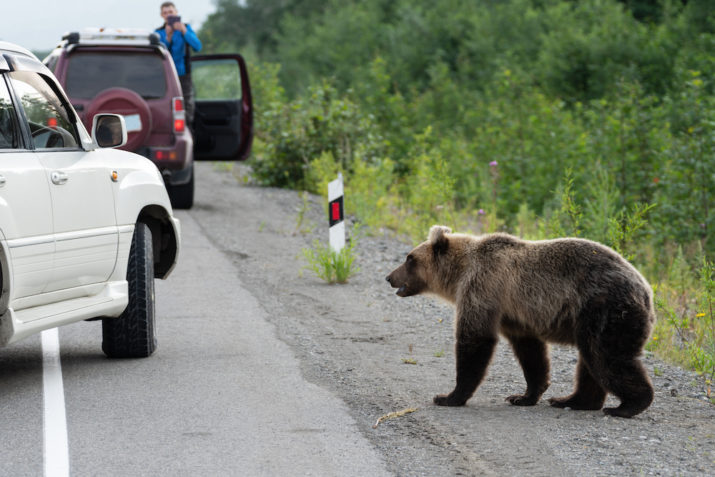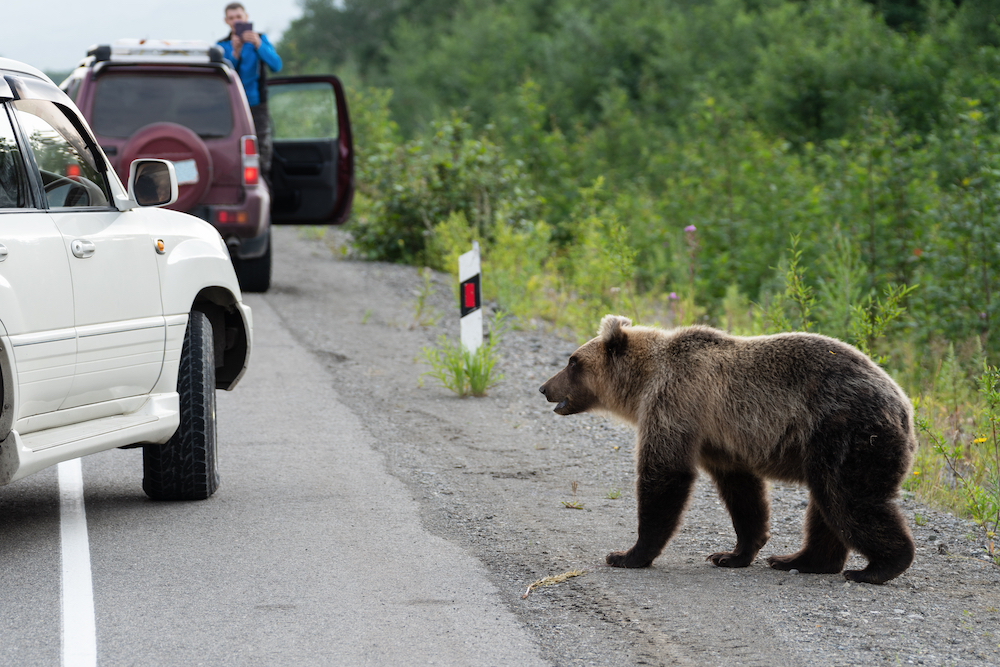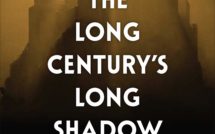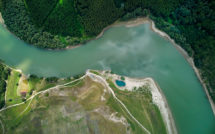

This is part of our special feature, Rethinking the Human in a Multispecies World.
Twice in the month of August, I dreamed of black bears. First, I dreamed of scat. Though I am not aware of ever having seen bear scat on our Appalachian ridge, my dream image matched some of the dark purplish piles I found online. In the second, the bears had arrived in numbers, taking over a room in my house, curling up on couches and pillows. My dream-self wondered if I might need to leave the house to them. Later, the bears had gone, the impressions of their round bodies still in the fabrics. I woke to the sensation that the dream was not entirely mine, that I had sidled up to the dream of the earth through some kind of shared language.
The next morning, when walking with my collie, Alba, on the spine of our ridge, she stopped, ears alert. Then she gave a low growl. Perhaps twenty yards down the trail, peering under an uprooted tree, was a black bear, smallish, surprisingly long-legged. In one terrifying moment, Alba rushed and I bellowed. I turned back up the path, away from the first bear I’d seen in over thirty years on this land. Miraculously, Alba turned back with me, and the bear loped away. I learned later that black bears are three quarters flight, one quarter fight. This one could very well have been an adolescent bear, dropped off by her mother because she was too old for the den. She was looking for her place in these woods. Though the wildlife rescue folks told me I need not alter my walking habits, Alba and I avoided the east side of our land in early morning for days. A week later, I heard rifle shots. I know that some of my neighbors eat bears. As suddenly as they came, the bears, I sensed, were gone. I would never see that lone bear again.
As a scholar and a poet who teaches at a university, I know that the field of animal studies asks us to include embodied human experience in our inquiry. And because of the mix of genres in which I write, I have long maintained that our feelings are part of the evidence. But what about our dreams? Ecocriticism asks us to entertain the idea of an animate and responsive earth, but our largely rationalist discourses leave us without tools for reciprocal forms of communication with the nonhuman. How do we go about opening ourselves to such exchanges? Poetry might be a better vehicle for exploring the uncanny.
Since reading Amitav Ghosh’s The Great Derangement: Climate Change and the Unthinkable (2016), I’ve been haunted by his argument that the stable climate we’ve taken for granted in the last several centuries has made it possible to assume a certain way of being human. We constructed a model of human rationality in a natural world we could think of as a stable setting against which human action might predictably unfold. Creatures of modernity, we thought we could do without dreams and visions unless perhaps in the confines of our churches or in the genres of our arts. But what if dreams, too, are part of the evidence, and not only in a Freudian or even a Jungian sense, but in a premodern and indigenous cosmological sense? I’m inclined to think that as a descendant of settler colonialists, my role is to listen without trying to adopt ways of knowing that aren’t mine. But I accept the gift of my waking and sleeping encounters with bears as an invitation to ponder what Ghosh describes as “the uncanny intimacy of our relationship with the nonhuman” (33).
As a novelist, Ghosh is preoccupied by the ways that the conventions of realist fiction are built around the probability provided by a stable climate; our own increasingly unstable weather and the new reality being created by it “are not easily accommodated in the deliberately prosaic world of serious prose fiction. Poetry, on the other hand, has long had an intimate relationship with climatic events” (26). Further, Ghosh suggests that the nonhuman world may be actively working to revise “those habits of thought that are based on the Cartesian dualism that arrogates all intelligence and agency to the human while denying them to every other kind of being” (31).
If the trees are speaking to us as Suzanne Simard has suggested in her recent Finding the Mother Tree (2021), and if the bears are speaking, as I’m persuaded they spoke to me, what are they saying? For Simard, trees are telling complex stories of multi-species interdependence: with the aid of mycorrhizal fungi they engage in communal exchanges that ensure the well-being of the forest. My dreams left me evidence of the seasonal habits of bears, scat turned purple by an autumn diet of acorns, hickory nuts, and berries. But in the second dream, the bears made a den of my home, and just as in my waking encounter, I was afraid. Indeed, part of the grief that emerged from that brief ridge meeting was knowing that neither I nor the bear were safe in each other’s presence. There are dogs, and there are guns. Black bears can be formidable when angry. Yet, the dream also contained the uncanny wish that we might somehow live together, a wish I share, even as I know no bear should lose its wild fear of humans. Still, it’s hard not to feel that the hunters in our woods shut down a conversation both I and the bear wanted to have.
As a scholar who also writes poetry, one of the ways I am trying to bring other ways of knowing and other kinds of evidence to bear on my writing is to integrate more of the associative, intuitive practices of poetry. I call this method Animal Poetics, and so far I have tried to employ it in two new essays I’ve written about rabbits and hares in contemporary Irish poetry. The guides I’ve set for myself in this writing include aspirations I may not be able to fulfill in every instance, but I’ve been guided by the joy I’ve discovered in this practice, a joy I had begun to lose in the more linear, analytic essays for which, as an academic, I have been trained. I think of animal poetics as both theory and practice, both the way a poem represents another animal and the way I try to write about that representation. It’s a horizon an essay might face into without necessarily reaching its goal. Here are the tenets I’ve sketched out for writing about other animals in poems:
- A refusal to reduce the animal exclusively to a symbol for purely human concerns. From Levi-Strauss’s “Animals are Good to Think” to John Berger’s “Why Look at Animals” to Herzog’s Cave of Forgotten Dreams, the point is continually made that human imaginative engagement with other animals as symbols has been foundational to human identity and that human art begins with their visual representation. Yet, the critical anthropomorphism that makes identification with and empathy for other animals mutually enriching, deteriorates when animals become solely metaphors, instrumentally reduced to objects in a symbolic system that may have little to do with the actual creature. As Josephine Donovan (2016) observes in her The Aesthetics of Care: On the Literary Treatment of Animals, an aesthetics of care “involves a sympathetic capacity to enter into the experience of another who is seen as a subject, not set apart as an object for ideological or aesthetic manipulation” (197).
- An undermining of our human exceptionalist tradition through poems in which animal lives, including individual animal lives, matter. As Donovan puts it: “Decentering human perspective … is a first step toward relating to the ‘other’—whether human or nonhuman nature—as a subject” (217). An animal poetics addresses other animals “as themselves affective individuals, capable of the kinds of bonds, empathy and grief we have historically ascribed only to humans” (Atkinson 2003, 2).
- An address of the abyss between human and nonhuman animal lives, such that neither radical differences between species nor empathetic multi-species engagements are denied. In The Animal that Therefore I Am, Jacques Derrida (2008) names the human practice of homogenizing the differences of all other species besides ourselves as simply “animal” with the term animot; the term ironically denotes the category humans have made for the primary purpose of constructing our identity in opposition to other animals. But Derrida also observes “I have . . . never believed in some homogeneous continuity between what calls itself man and what he calls the animal” (30). Animal poetics explores this “abysmal rupture” between humans and nonhumans.
- An attentiveness to the ways the experience of nonhuman animal presence shapes the language and the formal devices of a poem. Charging that in its reaction to poststructualism, ecopoetics has so far focused on poetry as mimetic and given too little attention to the materiality of language, Scott Knickerbocker (2012) in The Language of Nature, The Nature of Language, calls for a “sensuous poesis” which attends to the poem’s performance of human encounters with the nonhuman. “Sensuous poesis relies on the immediate impact on the senses of aural effects, such as alliteration, cacophony, and onomatopoeia, and visual effects such as enjambment and stanza shape, even as the words simultaneously invite the reflective consideration of the intellect” (17). In Knickerbocker’s terms, attending to the body of the poem calls forth our own embodied participation in the human-nonhuman animal encounters it performs.
- A willingness to allow the experience of the nonhuman animal presence to shape the language and form of scholarly inquiry itself, such that the always open-ended nature of human knowledge is named and the profound influence of the more-than-human world acknowledged. In “Hard Day’s Nights in the Anthropocene,” the closing essay of the collection, Ecopoetics: Essays in the Field, Joan Retallack (2018), a poet herself, shakes up the scholarly essay by reclaiming the experimental “prosimetrum,” “a dialogic genre alternating prose and poetry.” She offers this “genre-swerving writing practice” because, as she says, “imaginative swerves may lead to new paradigms that generate ethical energy from constructive optimism” (232).
At the end of September, two news stories about black bears in the western North Carolina Mountains near where I live emerged within days of each other. One was a report of a rare bear attack on the Blue Ridge Parkway near Asheville. In a season of high tourist density, required leashing for dogs, and high activity for bears as they feed and fatten before winter, a picnicking couple’s unleashed dog alarmed a young black bear who decided to fight rather than flee. Because the young bear failed to relent, attacking the car once the couple was in it, the search is on to find and euthanize her. The couple was treated for lacerations and released from an area hospital, their dog unhurt.
Whose land is this and with whom are we sharing it? In the second story, an elementary school in Asheville periodically goes into lockdown when bears visit the playground. A mother bear was taped using the slide, then urging her cub toward the smaller slide. Human commentary in the video is relaxed, empathetic, and playful as the humans share in the fun from a safe (indoor) distance. This is the kind of human-nonhuman animal interaction my practice of animal poetics attempts to celebrate and foster.
Kathryn Kirkpatrick is Professor of English at Appalachian State University where she teaches and writes about environmental literature, animal studies, and Irish studies from an ecofeminist perspective. She is the author of seven books of poetry, including collections addressing female embodiment, climate change, human illness, and nonhuman animals (Unaccountable Weather (2011) and Our Held Animal Breath (2012)). The Fisher Queen: New & Selected Poems(Salmon Press, 2019) was awarded the NC Literary & Historical Association’s Roanoke-Chowan Poetry Prize. For more about her work go to kathrynkirkpatrick.org.
References
Atkinson, Meera. 2013. “Animal Poetics: Singing the Scorched Tongue.” Southerly 73 (2): 1-5.
Berger, John. 1980. “Why Look at Animals.” In About Looking, 3-30. New York: Vintage Books.
Derrida, Jacques. 2008. The Animal That Therefore I Am. New York: Fordham University Press.
Donovan, Josephine. 2016. The Aesthetics of Care: On the Literary Treatment of Animals. London: Bloomsbury Academic.
Cave of Forgotten Dreams. 2010. Directed by Werner Herzog, Creative Differences.
Ghosh, Amitav. 2016. The Great Derangement: Climate Change and the Unthinkable. London: Penguin.
Kirkpatrick, Kathryn. (Forthcoming) “Doing the Human Differently: Rabbits and Hares in Irish Poetry.” In Contemporary Irish Poetry and the Climate Crisis, edited by Andrew J. Auge and Eugene O’Brien. Milton Park: Routledge.
Kirkpatrick, Kathryn. 2021. “Animals and Climate Crisis in Irish Poetry.” In The Cambridge History of Literature and the Environment, edited by Malcolm Sen. Cambridge: Cambridge University Press.
Knickerbocker, Scott. 2012. Ecopoetics: The Language of Nature, The Nature of Language. Amherst: University of Massachusetts Press.
Lévi-Strauss, Claude.1964. Totemism. Boston: Beacon Press.
Retallack, Joan. 2018. “Hard Day’s Nights in the Anthropocene.” In Ecopoetics: Essays in the Field, edited by Angela Hume and Gillian Osborne, 228-247. Iowa City: University of Iowa Press.
Simard, Suzanne. 2021. Finding the Mother Tree: Discovering the Wisdom of the Forest. New York: Knopf.
Photo: Wild, young, and hungry Kamchatka brown bear (Far Eastern brown bear) walking on road begging for food | Shutterstock
Published on November 9, 2021




